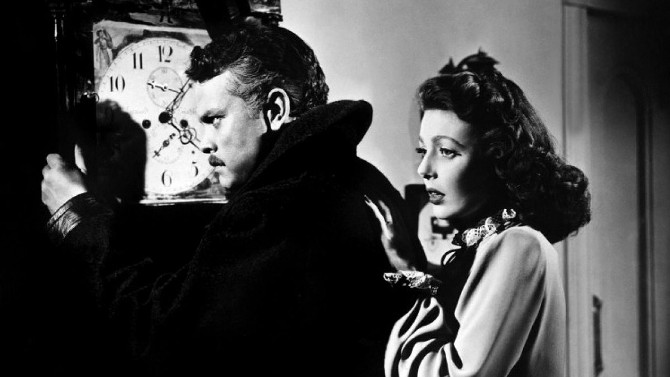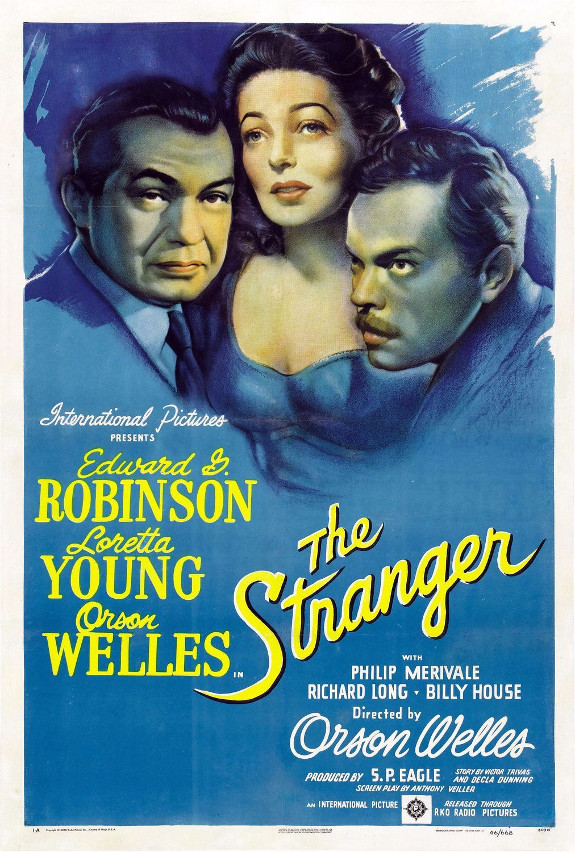It is Noirvember once again. . . the only time of the year when cynicism, doom-laden prospects and other dark themes should be sought out and applauded. The first film noir to grace Filmizon.com this November, 2017, is 1946’s The Stranger.
Directed by Orson Welles (his fourth feature, following the two classics Citizen Kane and The Magnificent Ambersons), this drama (with several film noir elements) follows Mr. Wilson (Edward G. Robinson – intriguingly, Welles originally wanted Agnes Moorehead portraying the lead as some sort of spinster lady), a sort of detective with the United Nations War Crimes Commission – or, to give his job a cooler name, he is basically a ‘Nazi Hunter’.
Set the same year as the movie’s release, the Commission, led by Wilson, are searching for one Franz Kindler, a cunning Nazi concentration camp mastermind who has been able to escape, hiding any record that could have pointed them in the proper direction. The only thing they know about him is that he has an obsessive passion, “a hobby that almost amounts to a mania – clocks”. Releasing one of his underlings, Konrad Meinike (Konstantin Shayne), he is their patsy, and they hope that he will lead them directly to the target.
Travelling across the Atlantic, Wilson follows the war criminal all the way to a small town in Connecticut, and, after being knocked out, the German meets a Professor named Charles Rankin (Orson Welles); the Nazi has transformed himself, creating this new identity. Marrying Supreme Court Justice Adam Longstreet’s (Philip Merivale) daughter Mary (Loretta Young), he has settled into the fabric of the community. He has even undertaken the task of fixing the antique clock that sits atop the church that rests at the centre of town.
By the time Wilson has awoken from his injury, Meinike has disappeared, and he must follow the sparse clues to discover if Kindler resides somewhere in his midst. Claiming to be an antique expert, he is welcomed with open arms into the community. Will he be able to discover the Nazi’s identity and trap the wily, dangerous man, or will he fail to capture the murderer?
Perhaps surprising to some, this was Welles’ first and only box office hit. . . neither of the above mentioned films (now considered to be classic pieces of cinema) did well upon their release – their complex stories and Welles’ visual flair unable to capture the imagination of the masses (studio issues did not help either). A more traditional offering, this dramatic thriller tones down his typical style, trimming the fat to develop a tight, taut, rather straightforward tale, which Welles often said was the least favourite film he made – though that should not take away from its entertaining premise.
The Stranger’s depth must be noted, as the gigantic locale is actually an intricate set, allowing for scenes to have a certain reality – the checkers playing sequences in the drugstore a perfect example. . . the view through the window building suspense, as well as showing the life of the town in the background. This is a rare find in films of this era. And, though it does not have the flair mentioned above, there are quite a few impressive, long single unedited takes (up to four minutes) – which not only shows the subtle skill of the director and excellent performances from the actors, but also allowed Welles to protect his work, as his contract gave the studio power in creative disputes and also gave editor Ernest J. Nims control to cut any material that was deemed irrelevant or unrelated to the advancement of the story. . . which led Welles to coin him “the great supercutter”. They also expected him to come in under budget as well as finish filming under the projected shoot time – he succeeded on both fronts.
Much of the picture’s suspense comes from the viewer knowing more than the characters onscreen. Wilson is always a step behind what we have already been shown (despite his obvious prowess at his job), and Mary, a loving, loyal wife, does not want to believe what she is being told, sticking by her man ‘for better or for worse’. Kindler (aka Rankin) is a formidable foe, a mastermind that is no slouch, and, like a wild animal, is at his most dangerous when forced into a corner.
Fascinating for its topical analysis of events occurring at the time, it was actually the first mainstream American movie to show real concentration camp footage following World War 2. As the film drives toward its powder keg of a finale, things swirl to a fever pitch of suspense as the Nazi villain attempts to cover his tracks once again. One scene near the conclusion finds Mary being held, one handed by Rankin, dangling precariously from the top of the belltower – a fascinating moment, it is even more astounding when you realize that it is not a special effect, it was actually shot in the church set with her hanging dangerously from on high.
An interesting noir crime drama, The Stranger is packed with intrigue, solid performances and a whole lot more. Despite the strict stipulations set upon Welles, his talent can still be spotted throughout – diverse shadow and light, severe angles, striking crane shots, and a depth that cannot be ignored. So, ring in Noirvember by watching this film that is all about a race against time, I doubt you’ll skewer it.


